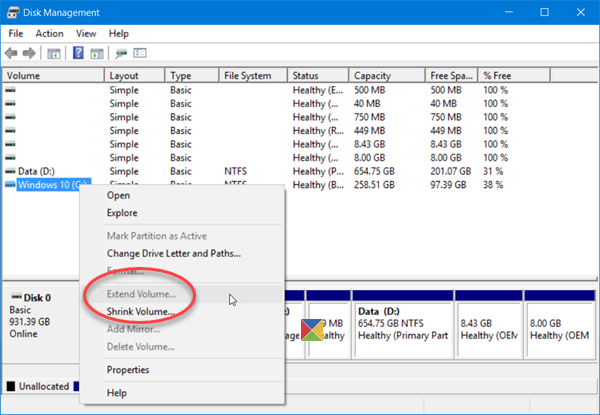If you find that the Extend Volume option is grayed out or disabled in Disk Management Tool in Windows 11/10, then this post will explain why this happens & what you can do about it. We can use the built-in Disk Management Tool or the Diskpart or Fsutil command-line tools to create, resize, extend, and delete partitions. But what if the Extend Volume option is grayed out or the Extend command fails?
The Windows operating system lets you extend any volume provided there is free or unallocated space on its right side. If there is no unallocated space, you will not be offered this option and it will appear grayed out.

Why is the Extend volume option grayed out?
These could be the possible reasons for the Extend volume option being grayed out. This could occur if there is no unallocated space on your hard drive. Also, if there is no contiguous unallocated space or free space behind the partition that you want to extend. Lastly, Windows can’t extend is a FAT or other format partition.
Extend volume option grayed out in Windows 11/10
If you need to extend the volume, you will need to delete the partition on the right side, i.e., behind the partition you want to extend and create unallocated space.
If it is your Data Drive that you want to extend, then there is a workaround. Say you have a System Drive – C and a data drive – D. You want to extend D drive, but the option is grayed out. What you can do is Shrink the System Drive to create unallocated space, which will be on the left side. Create a new volume with this unallocated space. Then move your data from the D drive to this new volume. Having done this, delete D Drive and then you will be able to extend the new drive since there will be unallocated space now on its right side.
Cannot extend Volume with unallocated space
If you want to extend your C or System Drive, copy all your data from your D or data Drive to an external drive or USB. Then delete the D volume. Now, you will be able to extend the C Volume. Utilize the space you want, and then create a new volume and name it D. Now, transfer your data back to the D drive from the external drive.
A few points to note about extending volumes, as mentioned by TechNet:
- The partition must have an associated volume before it can be extended.
- For basic volumes, the unallocated space must be on the same disk and it must follow the partition which you want to extend. That is, it must appear on the right side in Disk management.
- A dynamic simple or spanned volume can be extended to any empty space on any dynamic disk.
- If the partition was previously formatted with NTFS, the file system is automatically extended to fill the larger partition, and no data loss will occur.
- If the partition was previously formatted with a file system other than NTFS, the Extend command might fail.
- If the partition was not previously formatted with a file system, the partition would be extended.
Similar: All options greyed out in Disk Management
Why is Extend volume disabled in Windows 11?
When you see the Extend Volume option grayed out on your computer, it signifies no unallocated space on your hard disk. As there is no unallocated space after the C partition drive, the “Extend Volume” option is disabled. In this situation, you can free up some space first, then extend your partitions.
There are some free Partition Manager software that can help make the job of deleting, merging, and extending volumes easier. You might want to take a look at them.
TIP: See this post if the Delete Volume option is greyed out.
Leave a Reply